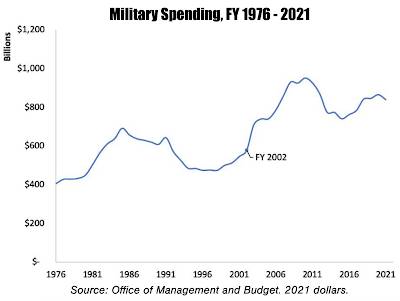
How Much Does the United States Military Cost American Taxpayers?
With the current conflict in Ukraine in mind and Congressional leaders’ insistence that Washington must arm Ukraine to fight against Vladimir Putin at all costs, a recent study by the Institute for Policy Studies (IPS) is particularly pertinent as it gives American taxpayers a sense of how much they are paying to the defense sector and how the funding of the military-industrial-intelligence complex compares to what Washington is spending on other important items.
Let’s start by looking at IPS’s “State of Insecurity: The Cost of Militarization Since 9/11” report. The authors of the report included the following as part of America’s military expenses:
1.) Department of Defense expenditures
2.) Department of Energy’s nuclear weapons activities
3.) Intelligence expenditures including the Central Intelligence Agency
4.) International military assistance
5.) Military retiree/veterans’ benefits
6.) Most programs in the Department of Homeland Security excluding FEMA.
7.) Federal law enforcement programs
All data is sourced from the Office of Management and Budget budget authority data and are inflation-adjusted to fiscal year 2021.
Between fiscal year 2002 and 2021, the following military spending took place (in 2021 dollars):
Department of Defense – $14.14 trillion
Military retirement and other programs – $1.27 trillion
Nuclear weapons programs – $460 billion
Aid for foreign militaries – $267 billion
CIA and other intelligence – $28 billion
This results in total military spending of $16.26 trillion over the two decade period after September 11, 2001.
Here is a graphic showing how military spending has grown (in constant 2021 dollars) since the mid-1970s and how it continues to remain at elevated levels:
Let’s look at a breakdown of spending by the Department of Defense. More than 70 percent or $9.9 billion of the Pentagon’s spending over the past two decades was for operations, purchasing, research and development. Breaking this down further, operations and maintenance spending on operating, deploying and maintaining weapons including ships and aircraft plus training totalled $5.7 trillion. Procurement costs which include purchasing and upgrading major weapons systems totalled $2.8 trillion. Compensation for military personnel accounted for $3.3 trillion in spending, noting that the entry-level pay for an enlisted service member in 2021 was the equivalent of a $10.30 hourly wage. The three biggest beneficiaries of Washington’s military generosity over the two decades were Afghanistan at $91 billion, Israel at $57 billion and Iraq at $36 billion; these three nations accounted for nearly 70 percent of all military assistance over the period.
It is also important to note that around half of the Pentagon’s budget goes directly into the pockets of the defense industry. Over the last 20 years, the defense industry took in more than $7.2 trillion in taxpayer-funded purchases compared to only $4.7 trillion in the 20 years before that which, as you may recall, included the peak years of the Cold War.
Now, let’s look at another analysis, again by the Institute for Policy Studies which looks at some tax facts for American taxpayers. Here is a summary of their findings and how Washington’s military spending compares to its other spending:
1.) the average taxpayer contributed about $2000 to the military in 2021 with almost half of that amount ending up in the pockets of corporate military contractors.
2.) the average taxpayer paid $929 just for Pentagon contractors in 2021 compared to $171 for Kindergarten to grade 12 education.
3.) the average taxpayer paid $62 for nuclear weapons compared to $27 for the Centers for Disease Control and Prevention.
4.) the average taxpayer paid $62 for deportations and border control compared to $5 for renewable energy.
5.) the average taxpayer paid $18 for federal prisons compared to $7 for anti-homelessness programs.
As you can see from this data, Washington’s spending on the military since September 11, 2001 has been profligate when compared to spending on the other key needs of society. As I noted in this posting, the defense industry is well aware that Washington is for sale and the corner office dwellers in the military-industrial-intelligence community are well aware of that fact and have been in a long-term buying mood.

Be the first to comment